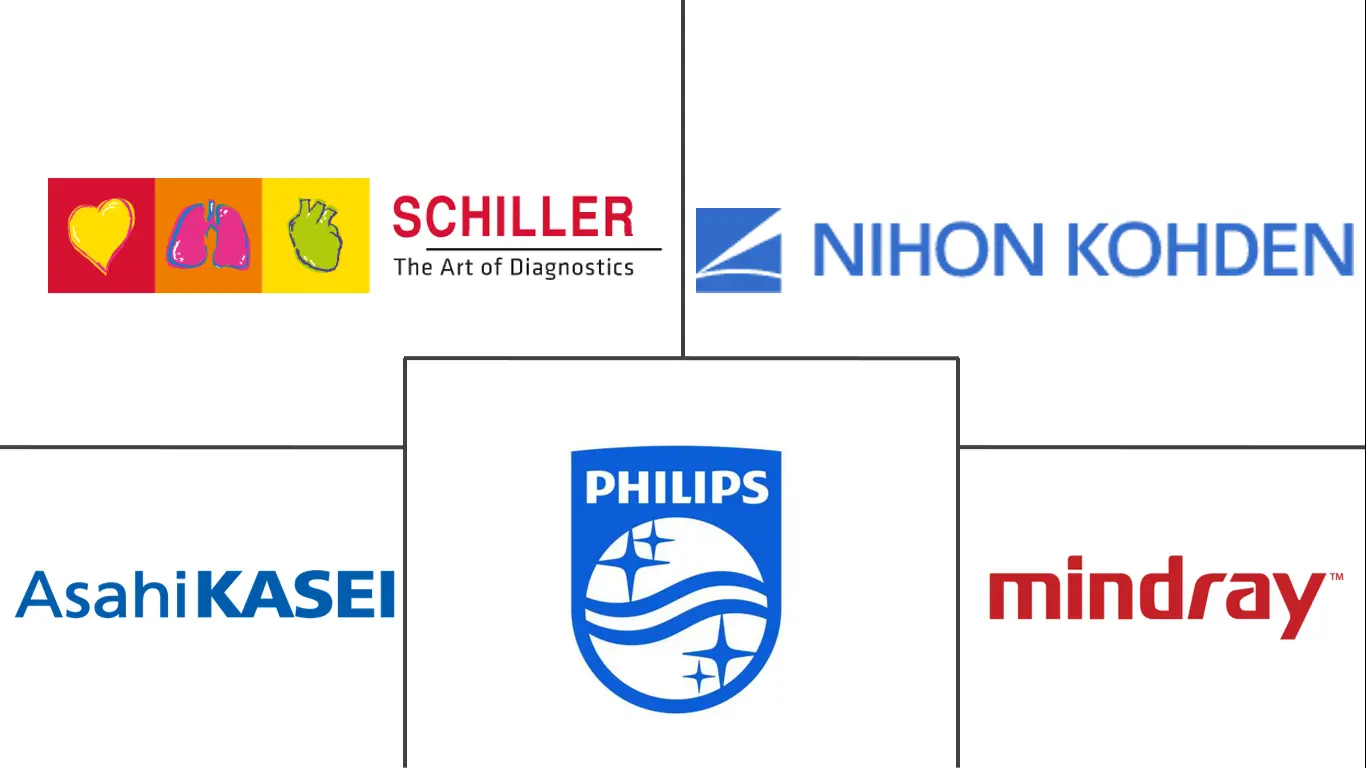External Defibrillator Market Size and Share
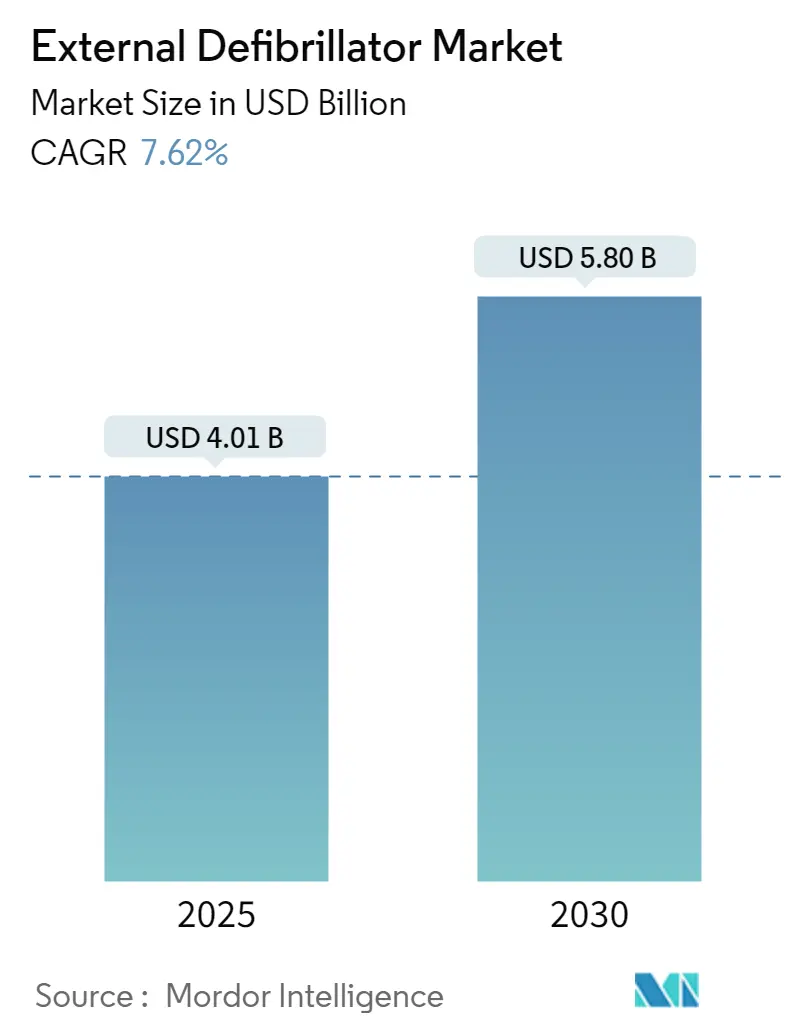
External Defibrillator Market Analysis by Mordor Intelligence
The external defibrillator market stands at USD 4.01 billion in 2025 and is projected to reach USD 5.80 billion by 2030, growing at a CAGR of 7.62% during the forecast period. This growth trajectory reflects the critical role these devices play in addressing the global burden of cardiovascular diseases, which remain the leading cause of mortality worldwide. The market's expansion is being fueled by technological innovations in wearable cardioverter defibrillators and automated external defibrillators (AEDs), which are transforming emergency cardiac care beyond traditional healthcare settings.
Asia-Pacific emerges as the fastest-growing region with a projected CAGR of 9.2% (2025-2030), driven by increasing healthcare infrastructure investments and rising cardiac disease prevalence. Public Access Settings represent the most dynamic end-use segment, growing at 11.3% annually as governments worldwide implement strategic AED placement initiatives to improve sudden cardiac arrest survival rates. The competitive landscape features established players like Philips and Stryker alongside emerging contenders such as Mindray, creating a market environment where innovation in device connectivity and artificial intelligence capabilities increasingly determines market share. A significant challenge facing the industry is the persistent gap between AED availability and utilization—despite widespread deployment, AEDs are used in only 4% of out-of-hospital cardiac arrests in the U.S., highlighting a critical implementation barrier that manufacturers must address through enhanced user interface design and public awareness campaigns.
Key Report Takeaways
- The external defibrillator market is valued at USD 4.01 billion in 2025 and projected to reach USD 5.80 billion by 2030, growing at a CAGR of 7.62%.
- Public Access Settings represent the fastest-growing end-use segment (11.3% CAGR), driven by government initiatives and increasing awareness of early defibrillation benefits.
- Automated External Defibrillators (AEDs) are outpacing other product segments with 10.2% CAGR (2025-2030), fueled by technological advancements and expanding public access programs.
- The pediatric segment is emerging as a significant growth opportunity (9.5% CAGR), supported by evolving clinical guidelines and specialized technology development.
- Asia-Pacific is the fastest-growing region (9.2% CAGR), presenting substantial market opportunities due to expanding healthcare infrastructure and increasing cardiovascular disease burden.
- Despite widespread AED deployment, utilization remains low (only 4% of out-of-hospital cardiac arrests in the U.S.), highlighting a critical implementation gap that requires addressing.
- Wearable cardioverter defibrillators are gaining clinical acceptance as bridge therapies, with high patient compliance rates and proven efficacy in preventing sudden cardiac death.
- Strategic acquisitions and ecosystem development are reshaping competitive dynamics, with market leaders expanding beyond hardware to integrated cardiac care solutions.
Global External Defibrillator Market Trends and Insights
Driver Impact Analysis
| Driver | (~) % Impact on CAGR Forecast | Geographic Relevance | Impact Timeline |
|---|---|---|---|
| Rising global incidences of cardiac diseases | +2.1% | Global, highest in Europe and North America | Long term (≥ 4 years) |
| Growing clinical acceptance of wearable cardioverter defibrillator | +1.8% | North America, Europe | Medium term (2-4 years) |
| Expansion of government-funded public-access defibrillation programs | +1.5% | North America, Europe, developed Asia-Pacific | Medium term (2-4 years) |
| Accelerating adoption of connected, cloud-enabled AEDs | +1.2% | North America, Europe, developed Asia-Pacific | Short term (≤ 2 years) |
| Favorable regulatory and reimbursement norms | +0.9% | North America, Europe | Medium term (2-4 years) |
| Increasing investments by players | +0.7% | Global | Short term (≤ 2 years) |
| Source: Mordor Intelligence | |||
Rising Global Incidences of Cardiac Diseases: Epidemiological Shifts Drive Demand
Cardiovascular conditions accounted for approximately 315 million coronary artery disease cases in 2022 as reported in JACC [1]Gregory Andrew Roth, "Global Prevalence of Coronary Artery Disease: An Update from the Global Burden of Disease Study," Journal of the American College of Cardiology, jacc.org. The nuance often overlooked is that regional prevalence spikes are now occurring earlier in life, shifting the age mix of potential external-defibrillator beneficiaries toward economically active cohorts. That demographic shift subtly amplifies the societal cost of each untreated arrest, thereby strengthening the economic justification for broader AED deployment inside workplaces instead of solely in retirement communities.
In Europe, cardiovascular diseases claim roughly 10,000 lives daily, with men nearly 2.5-times more likely to die from these conditions than women [2]World Health Organization, "Cardiovascular Diseases Kill 10,000 People in the WHO European Region Every Day, With Men Dying More Frequently Than Women," World Health Organization Europe, who.int. As a result, policy conversations are gradually pivoting from generic AED placement toward gender-specific response strategies—such as tailored public-awareness messages that describe atypical female symptom presentations. The strategic upshot for manufacturers is the emerging need to provide visual prompts and pads appropriate for varying chest anatomies, an engineering consideration largely absent a decade ago.
Growing Clinical Acceptance of Wearable Cardioverter Defibrillators: Beyond Traditional Implants
The LifeVest WCD, the only United States Food and Drug Administration (FDA)-cleared wearable defibrillator, demonstrated a 96 % one-year survival rate in a 2,000-patient registry disclosed by ZOLL Medical Corporation [3]ZOLL Medical Corporation, "What is the LifeVest Wearable Defibrillator?," ZOLL LifeVest, lifevest.zoll.com. A subtle derivative effect is that cardiologists are starting to use WCD compliance data as a surrogate marker for patient lifestyle traits when deciding on eventual implantable cardioverter-defibrillator (ICD) placement. Thus, WCDs are evolving from mere therapeutic bridges to diagnostic gatekeepers that guide long-term treatment trajectories.
Clinical studies on the Jewel patch-wearable cardioverter defibrillator (P-WCD) reported median daily wear times of over 21 hours. While the raw figure comes from non-peer-reviewed conference abstracts, the qualitative outcome is clear: sustained patient adherence is achievable when devices are designed as skin-compatible patches rather than vest-like garments. This insight is propelling research teams toward hypoallergenic adhesives and flexible batteries that conform to body contours, quietly redefining the ergonomics of emergency-class electronics.
Favorable Regulatory and Reimbursement Norms: Policy Acceleration
The American Heart Association (AHA) has set a target to double out-of-hospital cardiac arrest survival rates by 2030, aiming for bystander CPR rates above 50 % and pre-emergency-medical-service (EMS) AED application in at least 20 % of patients [4]Raina M. Merchant, "The American Heart Association Emergency Cardiovascular Care 2030 Impact Goals and Call to Action to Improve Cardiac Arrest Outcomes: A Scientific Statement From the American Heart Association," Circulation, ahajournals.org. One second-order ramification is that payers are reassessing coverage policies: insurers increasingly consider AED placement costs a preventive expenditure analogous to vaccination programs. This reframing unlocks reimbursement pathways that were previously unavailable to hardware suppliers.
The FDA’s strengthened oversight of AED manufacturing standards has elevated baseline quality expectations. From a competitive-strategy lens, smaller vendors now face higher conformance costs, subtly nudging the market toward consolidation. However, the same regulatory scrutiny incentivizes incumbents to open their internal quality-management systems for third-party audits, thereby turning compliance into a marketing differentiator that resonates with risk-averse hospital buyers.
Increasing Investments by Players: Strategic Capital Allocation
Philips’ acquisition of BioTelemetry integrated cloud-based monitoring into its defibrillator ecosystem. The less obvious implication is that insurers now have an entry point to negotiate value-based contracts centered on patient outcomes captured by integrated platforms. Consequently, the total addressable revenue pool is shifting from devices alone to recurring analytics and service fees, a migration reminiscent of trends previously observed in radiology equipment.
Meanwhile, the Jewel Patch demonstrated successful shock delivery in the vast majority of appropriate events during peer-reviewed trials, according to the Journal of the American College of Cardiology (JACC). Beyond its headline efficacy data, the pivotal contribution lies in its lightweight adhesive format, which halves logistics costs by minimizing packaging volume per unit—a factor of growing importance as e-commerce channels gain prominence for medical-device distribution.
Restraint Impact Analysis
| Restraint | (~) % Impact on CAGR Forecast | Geographic Relevance | Impact Timeline |
|---|---|---|---|
| High unit-replacement costs from battery & electrode consumables | -0.8% | Global, highest impact in emerging markets | Short term (≤ 2 years) |
| Supply-chain volatility for lithium batteries and semiconductor components | -0.6% | Global | Short term (≤ 2 years) |
| Lengthy regulatory approval delaying launches | -0.5% | North America, Europe | Medium term (2-4 years) |
| Low public awareness | -0.7% | Global, highest impact in emerging markets | Medium term (2-4 years) |
| Source: Mordor Intelligence | |||
High Unit-Replacement Costs: The Consumables Challenge
AEDs require routine battery and electrode-pad replacement. Hospitals often absorb these costs, but public-access programs depend on municipal budgets that renew only annually, creating maintenance gaps. The Cleveland Clinic highlights that LifeVest WCDs require daily battery changes. The hidden macro consequence is that budget-constrained local administrations increasingly explore subscription models where consumables are bundled into service contracts, effectively converting capex spikes into manageable opex streams.
Manufacturers responding with extended-life consumables could capture outsized loyalty; once a municipality standardizes on a brand to simplify logistics, switching becomes costly. Thus, battery chemistry innovation is not merely a cost-containment tactic but a strategic lock-in lever that influences long-term regional market share.
Lengthy Regulatory Approval Delaying Launches: Innovation Bottlenecks
The FDA’s rigorous review protocol for external defibrillators, particularly those employing novel energy-delivery algorithms, lengthens time-to-market. While this ensures safety, it also extends the payback horizon for investors. To mitigate risk, several companies are adopting a dual-track approach: iteratively enhancing cleared devices while simultaneously pursuing breakthrough applications under separate submissions. The subtle payoff is reputational; regulators tend to view incremental filings from proven manufacturers more favorably, indirectly increasing future approval probabilities.
The FDA cleared the Jewel P-WCD in April 2025. This milestone signals regulatory openness to next-generation non-invasive devices, yet the path to commercial scale will hinge on post-market surveillance data. Early adopters may thus wield disproportionate influence, as their real-world outcome reporting could either compress or prolong future review cycles for competing designs.
Segment Analysis
Product: Automated External Defibrillators Lead Innovation Wave
Manual external defibrillators held 38.9 % market share in 2024, but AEDs are projected to expand at a 10.2 % CAGR through 2030. AEDs are expected to account for about 55% of the external defibrillator market by 2030. Drone-delivered AEDs arrived before ambulances in 64 % of incidents in a Swedish field trial. The critical, though less cited, insight is that such drone deliveries generate high-resolution geospatial datasets on response times, which municipalities can harness to optimize broader EMS fleet positioning.
Moreover, AI-enabled rhythm analysis embedded in new AED models shortens the decision window between electrode contact and shock advisability. Each second saved compounds survival odds, but an under-appreciated consequence is that faster algorithms permit smaller processor footprints, enabling slimmer device enclosures. This design freedom is catalyzing new form factors, such as wall-mounted units comparable in depth to fire-alarm pull stations, which can be installed in high-traffic corridors without violating building-code protrusion limits.
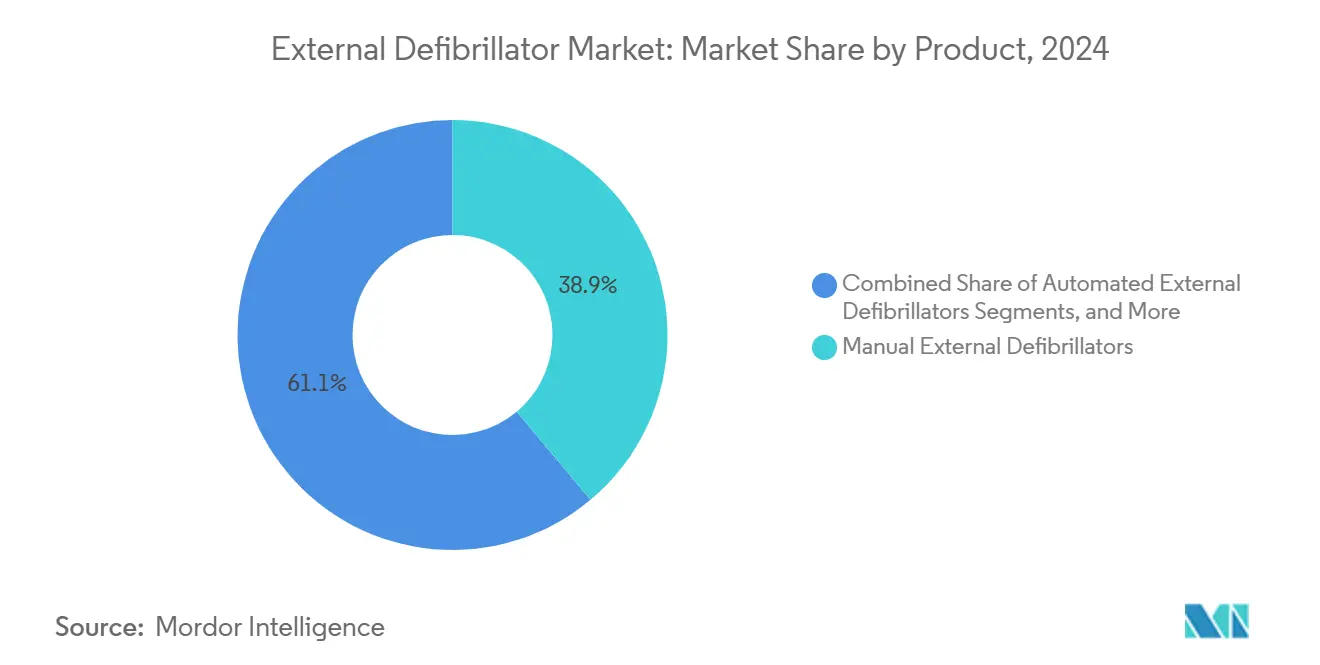
Note: Segment shares of all individual segments available upon report purchase
Patient Type: Pediatric Segment Emerges as Growth Frontier
Adults represented 89.5 % of the market in 2024, yet the pediatric category is projected to grow at 9.5 % CAGR through 2030. Updated AHA resuscitation guidelines underscore early AED use in children. Here lies a second-order insight: pediatric AED usage data doubles as an early-warning indicator for congenital heart anomalies in school populations, informing public-health screening initiatives that might otherwise require separate funding.
Research in Circulation links every 5-second pause in chest compressions during pediatric arrests to a 3 % drop in favorable neurologic outcomes. The operational takeaway for device makers is the necessity for pads that can be repositioned rapidly without losing adhesion, minimizing interruption whenever rescuers adjust hand positions. Developers that integrate visual cues for correct pad placement on smaller torsos can capture share in this specialized, yet underserved, sub-segment.

Note: Segment shares of all individual segments available upon report purchase
End-use: Public Access Settings Redefine Market Dynamics
Hospitals and cardiac centers controlled 61 % of revenue in 2024, but Public Access Settings are projected to expand at 11.3 % CAGR. Studies in Circulation indicate 53 % survival for recipients of public-access defibrillation versus 28.6 % for professional-only intervention. A less obvious implication is that corporate real-estate firms now view AED coverage as a tenant-attraction feature, similar to LEED certification. Consequently, landlords negotiating multiyear leases increasingly embed device refresh clauses, creating a predictable demand stream.
Mobile applications that pinpoint the nearest AED are proliferating. Beyond usage convenience, these platforms create anonymized heat-maps of device density relative to foot-traffic patterns, offering policymakers an empirical basis for targeted subsidy programs. Vendors that open their application programming interfaces (APIs) to civic-tech developers foster ecosystem stickiness, yielding incremental device sales as cities scale deployment.
Geography Analysis
The region holds 42.5 % of the 2024 market. In 2024 North America’s external defibrillator market size surpassed USD 1.70 billion, with the United States accounting for the majority share. The AHA plans to double survival by 2030 via improved accessibility. A lesser-known nuance is that federal grants for school safety increasingly stipulate AED procurement as an eligible expense, subtly expanding unit volume without explicit healthcare budgeting.
Washington, D.C.’s Fire and EMS Department launched an AED registry that feeds device locations to 9-1-1 dispatchers. The program’s unspoken benefit is data integrity: verified geotags enable computer-aided dispatch systems to algorithmically match callers with the nearest device, improving allocation efficiency in multi-incident scenarios.
Asia-Pacific
The region is forecast to record a 9.2% CAGR and exceed USD 1.60 billion market size by 2030. Rapid urbanization is intensifying cardiac risk factors while simultaneously placing people within reach of dense public-access device grids, setting up conditions for rapid adoption. Local manufacturers are carving out share via lower-cost AEDs tailored to regional budgets. The understated strategic insight is that several Asian firms bundle training apps in local languages, creating cultural fit advantages that western multinationals sometimes overlook.
Moreover, pilot drone-AED corridors in Japanese smart cities reveal an auxiliary application: drones simultaneously carry temperature-sensitive pharmaceuticals on return flights, optimizing fleet utilization. This multi-use logistics model strengthens the economic case for expanded drone infrastructure, indirectly favoring AED adoption by lowering per-delivery costs.
Cardiovascular diseases account for about 42.5 % of deaths in the WHO European Region. Europe’s external defibrillator market size is poised to reach roughly USD 1.20 billion in 2030. The Swedish drone-AED study achieved a 92 % successful delivery rate, arriving before ambulances in 64 % of cases. A subtler outcome was the creation of a low-altitude air-traffic-management protocol, which is now informing broader European Union unmanned-aerial-vehicle legislation, potentially accelerating cross-border AED drone services.
European procurement frameworks increasingly mandate environmental-impact disclosures. Manufacturers that can demonstrate lower carbon footprints in production and disposal are gaining scoring advantages in public tenders, implicitly nudging the industry toward sustainable material choices such as recyclable electrode pads.
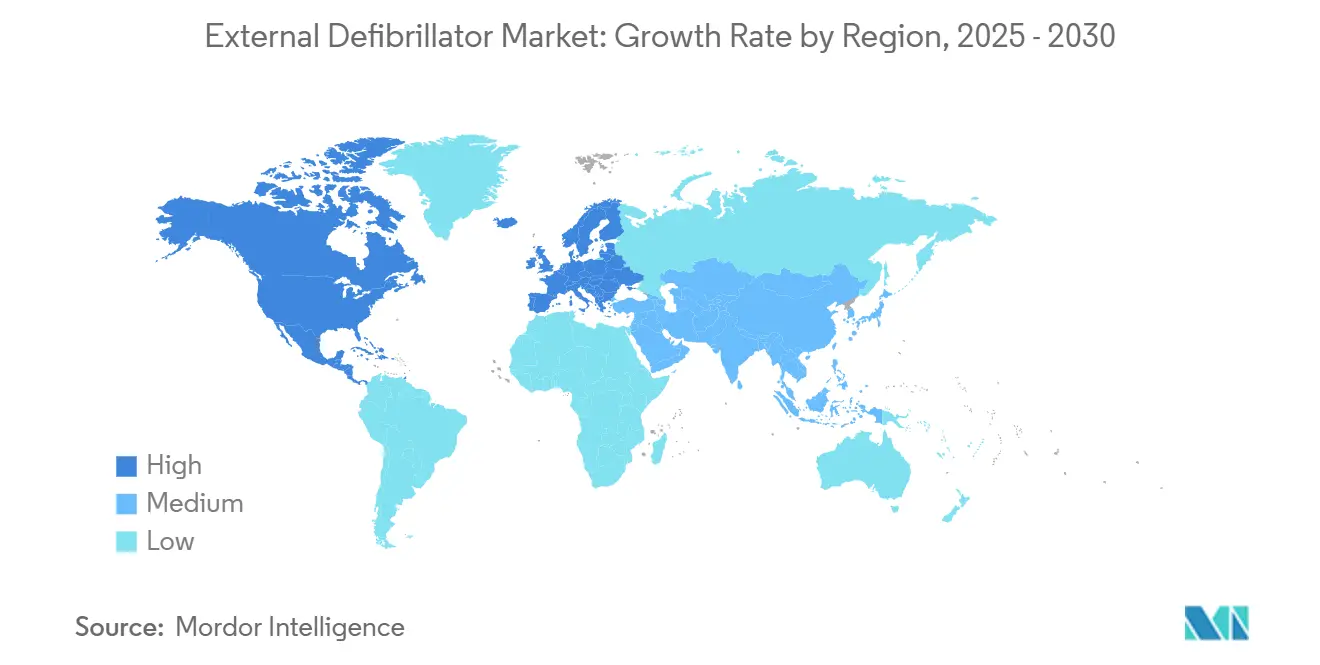
Competitive Landscape
The market displays moderate concentration. Philips, Stryker (Physio-Control), and Asahi Kasei’s ZOLL Medical dominate, collectively holding a majority share. An emerging competitive dimension is data ownership: by integrating remote monitoring companies, incumbents amass proprietary datasets that feed machine-learning algorithms, which in turn improve rhythm detection accuracy. This virtuous cycle can entrench market share by creating algorithmic performance gaps difficult for hardware-only rivals to close.
Mindray and CU Medical Systems are leveraging cost innovation to penetrate price-sensitive markets. Their strategy hinges on modular design, allowing customers to upgrade firmware for advanced analytics without replacing hardware. This incremental-upgrade pathway undermines traditional five-year replacement cycles, posing a long-term revenue-timing challenge for incumbents reliant on wholesale device refreshes.
A prominent white-space opportunity lies in end-to-end cardiac emergency ecosystems that integrate wearable or wall-mounted AEDs with EMS dispatch, hospital electronic-medical-record (EMR) systems, and post-discharge telehealth. Firms that orchestrate such data-flows could redefine competitive boundaries, moving the contest from individual device specifications to platform interoperability.
External Defibrillator Industry Leaders
-
Koninklijke Philips N.V.
-
Stryker (Physio-Control)
-
GE Healthcare
-
Boston Scientific Corp.
-
Asahi Kasei (ZOLL Medical)
- *Disclaimer: Major Players sorted in no particular order
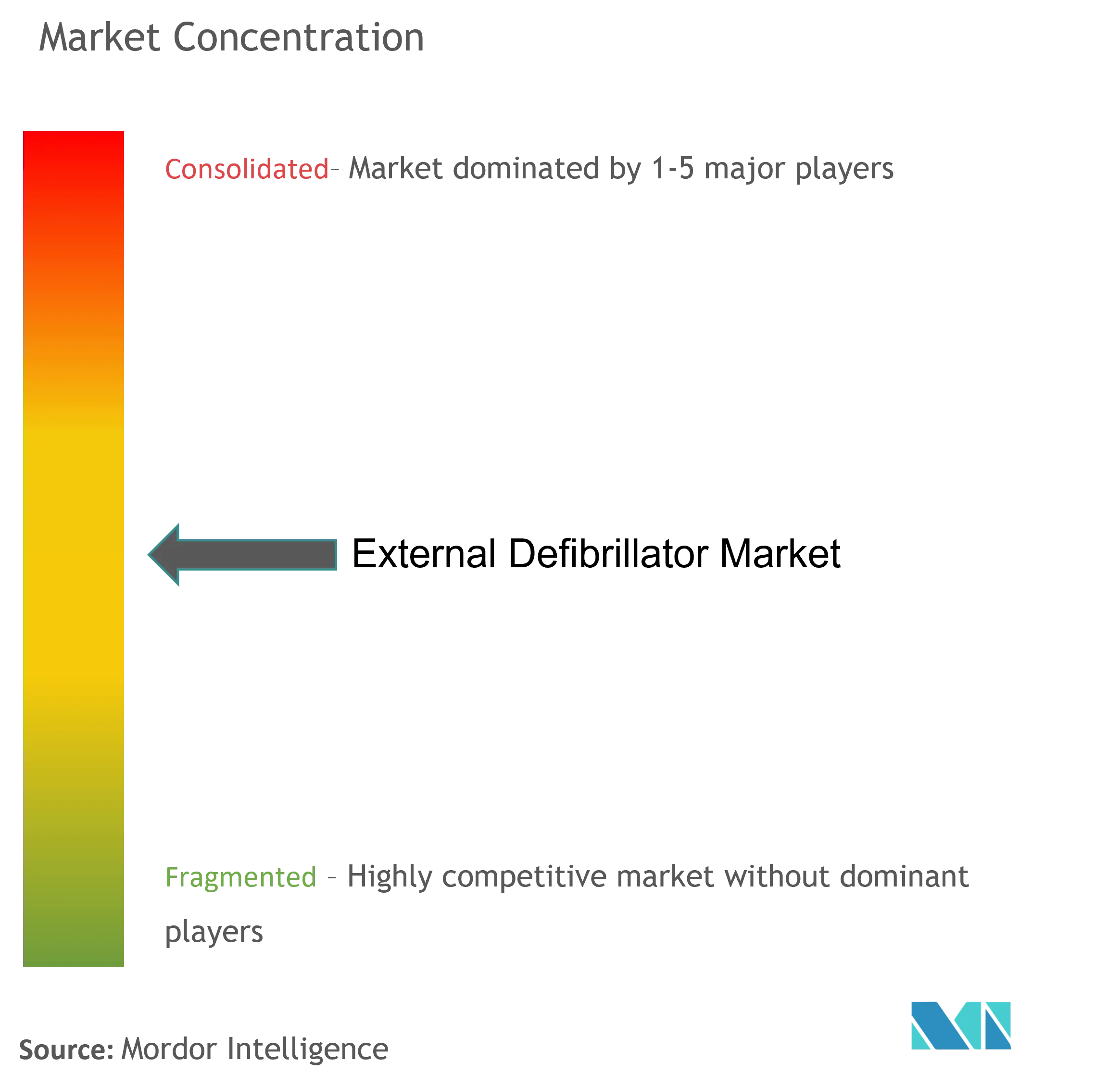
Recent Industry Developments
- April 2025: The FDA approved the Jewel patch-wearable cardioverter defibrillator, expanding therapeutic options for patients who are ineligible for implants. The approval is expected to catalyze a new sub-segment of adhesive, low-profile devices, positioning the market for convergence with consumer wearable electronics.
- April 2024: Avive Solutions secured USD 56.5 million in growth equity financing to accelerate the rollout of its connected AED across the United States. Although the investment comes from private sources, the strategic inference is that venture capital increasingly regards emergency-response devices as part of a scalable digital-health infrastructure rather than isolated hardware plays.
- March 2023: Safe Life acquired Coro Medical and AED.us to broaden nationwide distribution. The acquisition underscores the rising importance of direct-to-consumer and e-commerce channels in what was once a predominantly institutional market.
Research Methodology Framework and Report Scope
Market Definitions and Key Coverage
Our study treats the external defibrillator market as the worldwide sales value of new manual external defibrillators, automated external defibrillators (semi- and fully automatic), and wearable cardioverter defibrillators supplied to hospitals, emergency medical services, public-access programs, and home users during a calendar year.
Scope exclusion: Used or refurbished equipment, implantable devices, rental fleets, consumables, and post-sale services are not included.
Segmentation Overview
- By Product
- Manual External Defibrillators
- Automated External Defibrillators (AEDs)
- Semi-Automated AEDs
- Fully-Automated AEDs
- Wearable Cardioverter Defibrillators (WCDs)
- By Patient Type
- Adult
- Pediatric
- By End-use
- Hospitals & Cardiac Centers
- Pre-Hospital & EMS
- Public Access Settings
- Home Healthcare
- Alternate Care
- By Geography
- North America
- United States
- Canada
- Mexico
- Europe
- Germany
- United Kingdom
- France
- Italy
- Spain
- Rest of Europe
- Asia-Pacific
- China
- Japan
- India
- South Korea
- Australia
- Rest of Asia-Pacific
- Middle East
- GCC
- South Africa
- Rest of Middle East
- South America
- Brazil
- Argentina
- Rest of South America
- North America
Detailed Research Methodology and Data Validation
Primary Research
Cardiologists, resuscitation instructors, EMS buyers, and senior commercial managers across North America, Europe, Asia-Pacific, and Latin America were interviewed. Their guidance on adoption barriers, channel discounts, and replacement cycles allowed us to refine desk assumptions and align the model with on-ground realities.
Desk Research
We began by gathering sudden cardiac arrest and cardiovascular mortality statistics from tier-one public sources such as the World Health Organization, American Heart Association, and European Resuscitation Council. Trade volumes from UN Comtrade, FDA and European Medicines Agency clearance logs, and national customs codes helped set shipment counts and average selling prices. Company 10-Ks, investor decks, and EMS procurement databases clarified unit costs and installed-base churn, while news and deal trackers from Dow Jones Factiva, plus distributor revenues from D&B Hoovers, rounded out competitive signals. The sources mentioned illustrate our approach; many other open datasets informed the analysis.
Market-Sizing & Forecasting
We applied a top-down demand pool that multiplies documented sudden cardiac arrest incidence by guideline-recommended penetration targets, then subtracts the working installed base to derive annual unit need. Sampled supplier roll-ups (shipment volumes × blended ASPs) served as a bottom-up check. Core variables include public-access mandate counts, hospital cath-lab expansion, EMS fleet growth, device replacement intervals, and ASP shifts toward connected models. Multivariate regression against demographic aging, cardiovascular mortality, and health-expenditure growth produced forecasts to 2030, with scenario ranges validated by our primary respondents.
Data Validation & Update Cycle
Draft outputs pass peer review, anomaly checks, and currency normalization before sign-off. Mordor refreshes each model annually and triggers mid-cycle updates whenever material regulatory or recall events alter the data landscape, so clients always receive the latest baseline.
Why Mordor's External Defibrillator Baseline Earns Stakeholder Confidence
Published estimates often diverge because firms mix device classes, apply different price deflators, or lock forecasts to outdated base years. By matching scope to real procurement patterns and updating faster, Mordor offers a balanced midpoint decision-makers can trust.
Key gap drivers include exclusion of wearables by some publishers, uniform global ASP assumptions, and the bundling of training contracts or implantables into external figures, all of which shift totals away from our 2025 view.
Benchmark comparison
| Market Size | Anonymized source | Primary gap driver |
|---|---|---|
| USD 4.01 B (2025) | Mordor Intelligence | NA |
| USD 3.85 B (2024) | Global Consultancy A | Earlier base year; limited tracking of public-access units |
| USD 4.40 B (2024) | Industry Association B | Uses list prices without channel discount adjustments |
| USD 4.81 B (2023) | Regional Consultancy C | Bundles training and maintenance revenue into device value |
The comparison shows that while figures vary, Mordor's disciplined scope selection, transparent variables, and timely refresh cycle create the most reproducible and decision-ready baseline for planners and investors.
Key Questions Answered in the Report
What is the projected external defibrillator market size in 2030?
The global market is forecast to reach USD 5.80 billion by 2030, up from USD 4.01 billion in 2025.
Which region will experience the highest growth rate?
Asia-Pacific is expected to lead with a 9.2 % CAGR between 2025 and 2030, driven by healthcare infrastructure investments and rising cardiovascular disease prevalence.
Why are public access settings gaining market share?
Strategic placement of AEDs in public venues improves survival rates, and governments are incentivizing deployments to meet public-health targets, resulting in an 11.3 % CAGR for this segment.
What is the main barrier to wider AED utilization?
Despite extensive deployment, AEDs are used in only 4 % of out-of-hospital cardiac arrests in the United States, primarily due to bystander hesitation and insufficient public training.
Page last updated on:
